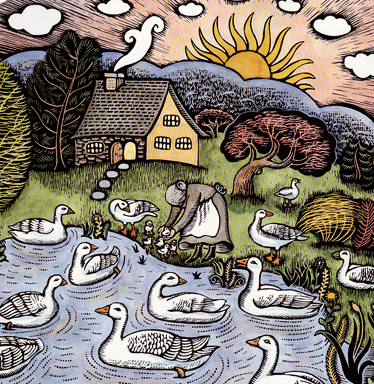Reviews for Grandmother Winter
Starred review: The Five Owls, Sept./Oct. 1999
The Brothers Grimm told tales of Mother Holle, a good fairy disguised as an old crone in order to test the heroine's virtue. This familiar German character, a childhood favorite of the author, has been transformed into Grandmother Winter, the primeval force behind the season. No test of morality or dramatic Persephone myth here. This is all about the pleasures and patterns of winter, evoked through the homespun artistry of tale and illustration.
This lovely weave of story and art evokes a timeless fairy-tale landscape. The first image is of a tiny cottage in the woods with an old woman stooped over ducklings beside a country pond. It is spring, and Grandmother Winter--like Mother Goose--is tending her geese as they "gabble and squawk, honk and hiss, flapping a storm of feathers." The feathers are important, as they become the stuff of a lacy quilt and, in time, the snow itself. Come autumn, the quilt is stuffed and ready for the longest night when, shaken the snow, flake by flake, begins to fall.
Then we enter, in Wallace Steven's words, "the mind of winter." The rest of the tale shows how the natural world and its human habitants greet the season. The illustrations, done on scratchboard with watercolor, reveal the intricate hibernating habits of all kinds of creatures during a winter in the wild. We see snakes coil in woodchuck dens, mice wrap around their tails in sleep, and frogs nestling in mud.
Children tuck into bed and dream of angel wings in the snow. The tone is quiet and sacred--and recalls, for me, Rachel Carson's "sense of wonder." The tale draws back to its beginnings as the geese also hide away and get ready for spring and "a new storm of feathers." Like the folktales that inspired this simple nature fable, the reader is left with a sense of the rightness of things, the circle of life returning.
Winter is blessed--as are we, the readers.
Ann Lundin
The Bulletin, Oct. 1999
In the first part of this original pourquoi tale, Grandmother tends her snow-white geese and then makes a quilt: "stitch by stitch,/ stuffing it full of feathers." Then, "when the days burn down/ toward the longest night," Grandmother shakes the quilt and "Flake by flake/ the snow begins to fall." The rest of the book documents what people and animals do "when Grandmother shakes her feather quilt": "children come running from their homes,/ catching snowflakes cold on their tongues"; "Brown bats hang head-down/ bundled in blankets of wings." The efficient rhythmic text is full of gentle action and color, making this a terrific readaloud, and the inevitable movement of all these creatures towards some form of hibernation makes this a natural for bedtime. There is an admirable specificity about animal names and behaviors, reinforced by the homey folk-art inspired scratchboard illustrations tinted with watercolors, which invite children to look "under leaves and in hollow logs" for where the "mourning cloak butterflies sleep." At home, at school, or at the nature center, with or without hot chocolate, this is a warm, satisfying read.
Kirkus, Sept. 1, 1999
Root (Aunt Nancy and Cousin Lazybones, 1998, etc.) presents Winter as a motherly old woman gathering up goose feathers during spring and summer, then making a white quilt that she shakes out, covering the land with snow. The text's quiet rhythms find perfect resonance in the crisp, idyllic colored scratchboard country scenes. It's a strong picture book debut for Krommes, and readers who place this plump, smiling farm wife next to the crusty geezer in Stephen Gammell's Is That You, Winter? (1997) will find the contrast of personalities amusing.

